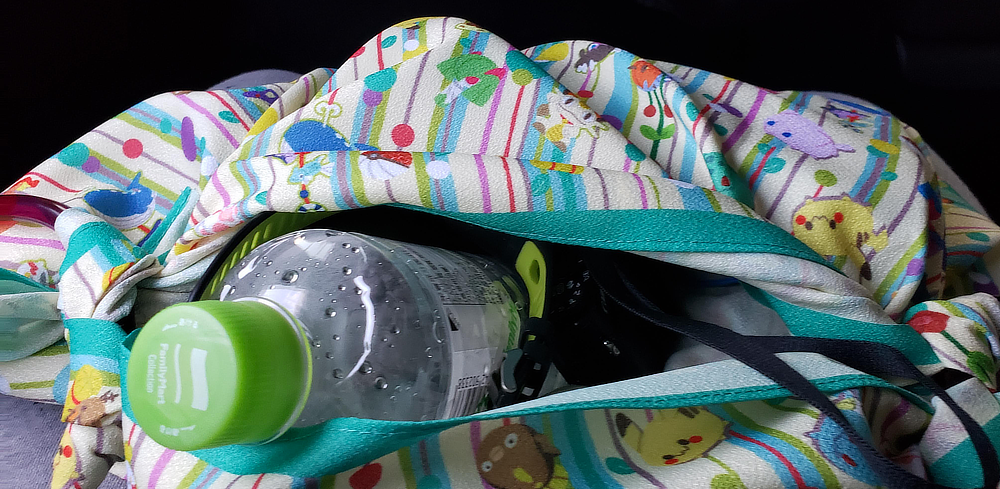Gosh, where do I start with this obsession of mine I've decided to tell you about? Well, to start, I wasn't aware of furoshiki when we landed in Osaka. I had seen them before, in movies and anime, but had no idea what the thing I had seen was actually called. This is, to me, one of the fun things about travel: you invetiably fill in the gaps for things you already knew, but didn't know.
Our first week in Osaka was very "hit the ground running" so to speak, in terms of culture shock. Maybe shock is the wrong word to use here, because I don't want to imply that it was painful or unpleasant, just suddenly very different. I have now been to Scotland, an airport in the UK, another in Germany, and France for a week, so I felt ready for the challenge of introducing myself to Japan. We were going to be friends, and I would visit, to enjoy myself on Japan's terms, politely and with enthusiasm.
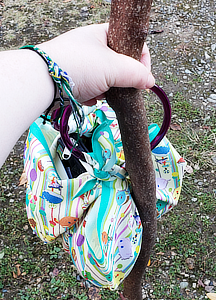
We spent two days in Osaka, and they were wonderful and fun. Osaka is that fun friend that you're always happy to see show up, and I look forward to hanging out with them again. Next, we took a train with all our luggage, up north to Sasayama. Here was our base of operations, so to speak, where we stayed with our friend Deven for a few weeks, and took little trips from his house via the JR system. Once we got out into the countryside, the quiet, absolutely picturesque Japanese countryside, the jetlag caught up with us, and we took a few days to do laundry, eat ramen at a local place, and go to an onsen resort. I will say, hotels that book a lot of global travelers need to have a good onsen, but that's for another time.
As we were packing for the onsen, I noticed Yumi, Deven's wife and officially very fun person, wrapping up her Nintendo switch in this cloth, with some complicated folding to make a pocket. Now, I am quite familiar with origami, and have in the past, littered my desk with lots of little paper friends, so I was into the idea of doing some sweet folds with cloth to make a pocket. I asked her to show me what she was making, and she explained she was sort of making it up on the fly, so I just did my best to watch and learn. Then, she pulled another cloth out, and showing me her steps, tied some knots in the corners, wrapped them around two wooden hoops, and handed the bundle to me. She explained this was a purse for me to borrow while we were at the resort, and that it was made with a furoshiki cloth.
Allow me to pull some information from Wikipedia for you at this point. The idea of using a furoshiki (meaning "bath spread") cloth dates pretty far back in Japanese culture, and originally was used as a way to bundle and contain clothes when visiting a bath. Now, in a world quickly becoming more eco-aware, modern furoshiki have been used widely as wraps for gifts, bento boxes, and grocery bags, as a start. With one sturdy square cloth, finished around the edges, a person can make multiple different kinds of useful and elegant things. Put a few cloths in your pocket when you got to the store, and voila, instant grocery bag for starters.
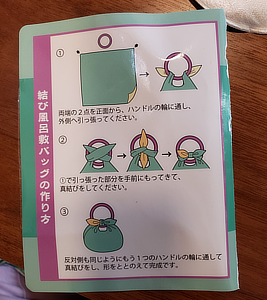
I was instantly obsessed, and did my best to be subtle about this, but I also failed horribly at doing so. When we had access to wifi, I did all I could to find more and more diagrams of various folding methods, and every time we were in a shopping area, I poked around for furoshiki shops. It wasn't until we visited Canal City in Hakata, that I was left alone in a store, with $100 to spend just on furoshiki, that I was able to successfully begin to build my collection. I was in that store for a solid 30 minutes, doing my best to use the Google Translate to read the labels, and see what sizes the different cloths were, what they were made of, how best to use them. I was making a very serious decision, and I would make it carefully and at my own pace. In the end, I picked out a larger cloth, that had been treated to be waterproof, and was big enough to make a shoulder bag from. Then, I picked out a large wooden handle, with holes to bring the corners of the cloth through, and magnets to snap shut. I had officially become an owner of a real and completely amazing furoshiki bag. It became my day-bag for our trips and I was always poking at the knots when we stopped somewhere, to tie and retie it in different patterns.
As we traveled to more areas, I found more and more shops, as I learned what to look for. There are also things called Tenugui, which is a thin hand towel, also widely used, but not the same thing. I found plenty of those that were decorated with lovely patterns, but would not work for what I wanted as well. I got other handles, and different cloths of smaller sizes. I was also complimented, at one point, on my bag, which was such an amazing moment. I was standing in the Ghibli Museum, surrounded and squished by many other people who were just as eager as me to look at sketchbooks and storyboards of Miyazaki's work, when an older woman got my attention and complimented me on my bag and knotwork. I do not exaggerate when I say I will carry her praise with me to my last days.
Now, this is all fine and good, you say. Girl takes one aspect of a complex and rich culture, finds it's amazing (people knew this for a long time, Harmonie) and acts as if she's discovered something new. To me, it was, and I felt a little silly that it should be. It's a simple idea, just one that hasn't really taken off in my neck of the woods yet. I personally feel like it should, and sometimes surprise myself with how strongly I feel about it. When I came home, I imagine my other bags waited with open pockets to welcome me back, and felt worried when they saw my slight furoshiki mania. No one was thrown out or replaced, every bag has it's uses and now I've begun to use smaller cloths to wrap and contain things when using a larger shoulder bag or luggage. Maybe I will even try to sew my own.
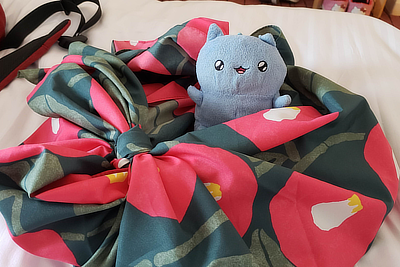
I'll leave you with one more story on this subject. As our trip came to a close, Deven suggested we take a day trip, to Kyoto and see a bamboo forest. Since we were there in late November, this was a great way for us to get our fill of fall leaves and so we headed off early in the morning by car, then by train, to get to Tenryu-ji temple. Tenryu-ji was built in about 1339, and is an important Buddhist temple, surrounded by gardens, walking trails, and a downtown of shops, restuarants and cafes. As we walked around, I decided to stop off to the side outside one of the cafes and to re-tie some of my knots. I had been using a smaller cloth to keep smaller items like chapstick together, and as the day progressed, had squirreled away more souveniors inside that could be distributed better. My husband, Deven, and Yumi wandered into the crowded cafe, and I crouched down on the pavement to untie and spread out my bag.
The useful thing with these bags, is that by undoing the knots, everything was already pretty much contained and in the middle of the cloth already, so it usually takes a quick adjustment of how big you want the handle to be, or how much room you need for things, and then you're off again. This time, I tried a few configurations, and as I sat there deciding, a very elegant, older Japanese woman crouched down next to me, and nodded in approval of what I was doing. I looked up, suprised, and instantly worried I had behaved too weirdly and should pick things up and move, but she stopped me and waved her hands to try to show me how to tie up a part of my bag.
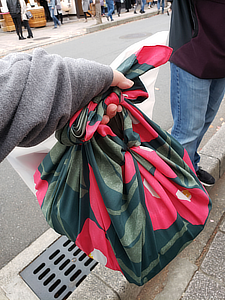
Now, I speak very little Japanese, mostly only enough to be polite. I had previously learned the phrase "kore wa nan desu ka?" by saying it over and over quietly, so I could ask our waitress in a brewery in Nara the week before, what the little crispy sticks she'd given us, were made out of. When she gave me the most lovely smile and answered me in English that they were fried udon noodles, I instantly decided to become an expert at the phrase. I was still not comfortable at "Itadakimasu!" before every meal, and would sound it out quietly while nodding along. I most certainly though, did not have enough Japanese in my head to express to this kind woman how much I loved furoshiki and would be happy to learn whatever she felt gracious enough to show me, so I just did my best with gestures, lifting my hands up and back from my bag.
She quickly and assertively took two opposite corners, confidently pulled them into a strong knot, then layered the other corners over them, and added another solid knot. Then, through some magic I'm still trying to remember, she used all four ends to make a handle of the cloth, and gestured for me to try it out. I did, carefully picking up the bag, my eyes going wide at how solid it felt, how easy to carry and balanced the contents inside suddenly felt. I did my best to thank her, and she smiled at me and walked away, as my husband and friends came back out of the cafe. Apparently, they had been watching from inside, as I "made a new friend" and she helped me with my bag. Flabbergasted and completely excited, I poked again at the knots to try to figure out how to replicate what she had done. Before I knew it, she was back, and she showed me again how to make them, watching me as I tried out the pattern. My husband said that it looked like her and another woman had been watching me try out different configurations, and evidently she had just decided to take a chance on a stranger.
In a way, this is a small metaphor for me, regarding my approach to meeting people. I always want to assume the best of people, although I'm not quite so far gone as to quote Scarlett O'Hara's bit about the kindness of strangers. I do expect people to be "just as afraid of me as I am of them" and when traveling this feeling is turned up a few more notches. For me to find joy in learning about this aspect of Japanese culture, and then be welcomed and taught by two different people, made me feel like something perfect had happened. In a small way, it was less about the bag itself, and about seeing a common ground with each other, and that to me at the end of the day, friends, is part of why we travel in the first place.





